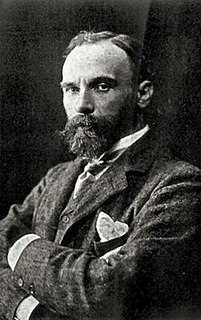 W
WJohn William Waterhouse was an English painter known for working first in the Academic style and for then embracing the Pre-Raphaelite Brotherhood's style and subject matter. His artworks were known for their depictions of women from both ancient Greek mythology and Arthurian legend.
 W
WBoreas is an oil painting in the Pre-Raphaelite style created in 1903 by John William Waterhouse.
 W
WCirce Invidiosa is a painting by John William Waterhouse completed in 1892. It is his second depiction, after Circe Offering the Cup to Ulysses (1891), of the classical mythological character Circe. This particular mythological portrayal is based on Ovid's tale in Metamorphoses, wherein Circe turns Scylla into a sea monster, solely because Glaucus scorned the enchantress' romantic advances in hopes of attaining Scylla's love instead. Waterhouse later returned to the subject of Circe a third time with The Sorceress (1911). Circe Invidiosa is part of the collection of the Art Gallery of South Australia, which also owns Waterhouse's The Favourites of the Emperor Honorius.
 W
WCirce Offering the Cup to Ulysses is an oil painting in the Pre-Raphaelite style by John William Waterhouse that was created in 1891.
 W
WConsulting the Oracle is an oil on canvas painting by John William Waterhouse. Waterhouse painted it in 1884; according to Anthony Hobson, "The Illustrated London News described it as one of the principal works of the year". Hobson describes the work as having a "keyhole composition" because a partial ring of women focus upon a single other.
 W
WThe Crystal Ball is a painting by John William Waterhouse completed in 1902. Waterhouse displayed both it and The Missal in the Royal Academy of 1902. The painting shows the influence of the Italian Renaissance with vertical and horizontal lines, along with circles "rather than the pointed arches of the Gothic".
 W
WEcho and Narcissus is a 1903 oil painting by John William Waterhouse. It illustrates the myth of Echo and Narcissus from Ovid's Metamorphoses.
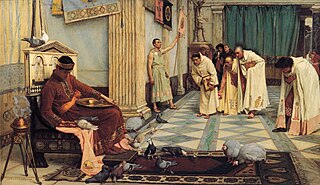 W
WThe Favourites of the Emperor Honorius is a painting by John William Waterhouse completed in 1883. The painting depicts Honorius feeding birds which are on the rug in front of him; the dark colors of the rug and his clothes define a space. Separated from him and the birds are the councillors seeking his attention, and who along with the attendant are dressed in paler shades.
 W
WGather Ye Rosebuds While Ye May is an oil painting on canvas created in 1908 by British Pre-Raphaelite artist John William Waterhouse. It was the first of two paintings inspired by the 17th century poem "To the Virgins, to Make Much of Time" by Robert Herrick which begins: Gather ye rosebuds while ye may, Old Time is still a-flying; And this same flower that smiles today Tomorrow will be dying.
 W
WGather Ye Rosebuds While Ye May is an oil painting on canvas created in 1909 by British Pre-Raphaelite artist, John William Waterhouse. It was the second of two paintings inspired by the 17th century poem "To the Virgins, to Make Much of Time" by Robert Herrick which begins:
 W
WHylas and the Nymphs is an 1896 oil painting by John William Waterhouse. The painting depicts a moment from the Greek and Roman legend of the tragic youth Hylas, based on accounts by Ovid and other ancient writers, in which the enraptured Hylas is abducted by Naiads while seeking drinking water.
 W
WI Am Half-Sick of Shadows, Said the Lady of Shalott is a painting by John William Waterhouse completed in 1915. It is the third painting by Waterhouse that depicts a scene from the Tennyson poem, "The Lady of Shalott". The title of the painting is a quotation from the last two lines in the fourth and final verse of the second part of Tennyson's poem:
 W
WJason and Medea is an oil painting in the Pre-Raphaelite style created by John William Waterhouse in 1907.
 W
WThe Lady of Shalott is a painting of 1888 by the English painter John William Waterhouse. It is a representation of the ending of Alfred, Lord Tennyson's 1832 poem of the same name. Waterhouse painted three versions of this character, in 1888, 1894 and 1915. It is one of his most famous works, which adopted much of the style of the Pre-Raphaelite Brotherhood, though Waterhouse was painting several decades after the Brotherhood split up during his early childhood. The Lady of Shalott was donated to the public by Sir Henry Tate in 1894 and is usually on display in Tate Britain, London, in room 1840.
 W
WThe Lady of Shalott looking at Lancelot is an oil-on-canvas painting by John William Waterhouse, completed in 1894. It measures 142.2 by 86.3 centimetres. The artist presented it to Leeds Art Gallery in 1895.
 W
WThe Magic Circle is the name of two 1886 oil paintings in the Pre-Raphaelite style by John William Waterhouse. The paintings depict a witch or sorceress using a wand to draw a fiery magic circle on the earth to create a ritual space for her ceremonial magic.
 W
WMariana in the South is an 1897 oil painting on canvas by the British Pre-Raphaelite artist, John William Waterhouse. It is now in a private collection. It measures 114 by 74 centimetres. It is a major painting by Waterhouse that depicts scenes from the 1830 Tennyson poem, "Mariana". Mariana prays for the return of the lost love, the dictator Angelo, who brutally spurned her on the loss of her dowry. The picture illustrates the line "And in the liquid mirror glowed the clear perfection of her face" from Tennyson's poem.
 W
WOphelia is a 1894 oil on canvas painting by the English painter John William Waterhouse, depicting a character in William Shakespeare's drama Hamlet. She is a young noblewoman of Denmark, a potential wife for Prince Hamlet. In the 1894 version by Waterhouse, Ophelia is depicted, in the last moments before her death, sitting on a willow branch extending out over a pond of lilies. Her royal dress strongly contrasts with her natural surroundings. Waterhouse has placed flowers on her lap and in her hair, tying her into her natural surroundings.
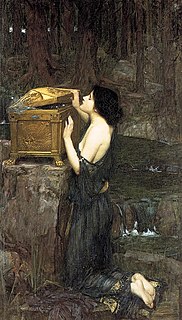 W
WPandora is a c.1896 painting by John William Waterhouse, now in a private collection.
 W
WSaint Eulalia is an oil painting on canvas in the Pre-Raphaelite style, created in 1885 by English artist John William Waterhouse, depicting the aftermath of the death of Eulalia of Mérida. It is currently housed at Tate Britain.
 W
WThe Siren is a painting by John William Waterhouse. The painting depicts a siren sitting at the edge of a cliff, lyre in hand, staring down at a shipwrecked sailor floating in water, who in turn is staring up at her.
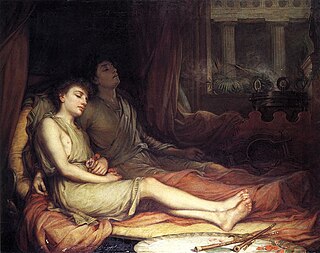 W
WSleep and his Half-brother Death is a painting by John William Waterhouse completed in 1874.
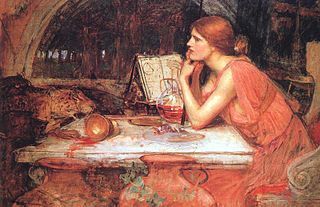 W
WThe Sorceress is a painting by John William Waterhouse completed between 1911 and 1915. It is his third depiction, after Circe Offering the Cup to Ulysses (1891) and Circe Invidiosa (1892), of the Greek mythological character, Circe, and her name is on the back of the canvas. The inclusion of leopards and the loom offer further evidence that the painting is of Circe.
 W
WUlysses and the Sirens is an 1891 painting by Pre-Raphaelite artist John William Waterhouse. It is currently held in the National Gallery of Victoria, Melbourne, Australia.
 W
WThe Unwelcome Companion: A Street Scene in Cairo is an early painting by John William Waterhouse. Completed in 1873, it was exhibited at the gallery of the Society of British Artists.